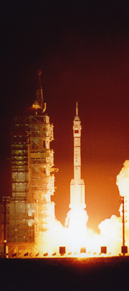

报告题目:Understanding CMEs Viewed in Coronagraphs
报告人:汪毓明(教授,中国科学技术大学地球和空间科学学院)
地 点:空间天气学重点实验室学术活动室(九章大厦A0709)
时 间:2010年10月25日(星期一)14:30
欢迎参加!
摘要:
How to properly understand coronal mass ejections (CMEs) viewed in white-light coronagraphs is crucial to many relative researches in solar and space physics. The issue is now exhaustively addressed through studying the source locations of 1078 LASCO CMEs listed in CDAW CME catalog during 1997 -- 1998 and their relationships with CMEs' apparent parameters. By manually checking LASCO and EIT movies of these CMEs, we find that, except 231 CMEs whose source locations can not be identified due to poor data, there are 288 CMEs with location identified on the front-side solar disk, 234 CMEs appearing above solar limb, and 325 CMEs without evident eruptive signatures in the field of view of EIT. Based on the information of CMEs' source locations, the visibility of CMEs in EIT and white-light coronagraphs, the causes of halo CMEs and the deflections of CMEs in the corona are analyzed. Lots of interesting results are found. For example, (1) about 16% of CMEs originated from the front-side solar disk but did not leave any evident eruptive signatures in EIT, and about 19% of CMEs were probably missed by LASCO; (2) the brightness of CMEs in white-light coronagraphs is positively correlated with CMEs' apparent speeds, which implies that a bright erupting feature in coronagraphs mainly reflect the compressed ambient solar wind plasmas but not the CME itself, and the estimated CME `mass' probably include both the CME net mass and virtual mass; (3) energetic release of free energy is one of the major causes of halo CMEs, especially for limb halo CMEs, and about 25% of halo CMEs are more energetic than the average level of CMEs; (4) about 62% of CMEs deflected toward equator, and about 5% of CMEs manifested an obvious pole-ward deflection.